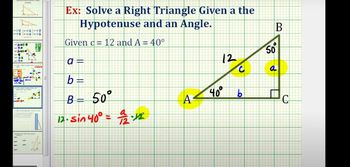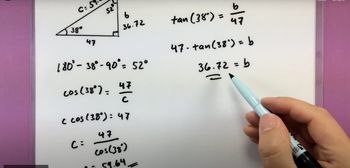Table of contents
- 0. Review of College Algebra4h 43m
- 1. Measuring Angles39m
- 2. Trigonometric Functions on Right Triangles2h 5m
- 3. Unit Circle1h 19m
- 4. Graphing Trigonometric Functions1h 19m
- 5. Inverse Trigonometric Functions and Basic Trigonometric Equations1h 41m
- 6. Trigonometric Identities and More Equations2h 34m
- 7. Non-Right Triangles1h 38m
- 8. Vectors2h 25m
- 9. Polar Equations2h 5m
- 10. Parametric Equations1h 6m
- 11. Graphing Complex Numbers1h 7m
2. Trigonometric Functions on Right Triangles
Solving Right Triangles
Problem 21a
Textbook Question
In Exercises 18–24, graph two full periods of the given tangent or cotangent function. y = −tan(x − π/4)
 Verified step by step guidance
Verified step by step guidance1
<Step 1: Identify the basic function.> The given function is a transformation of the basic tangent function, \( y = \tan(x) \).
<Step 2: Determine the transformations.> The function \( y = -\tan(x - \pi/4) \) involves two transformations: a horizontal shift and a vertical reflection. The horizontal shift is \( \pi/4 \) units to the right, and the negative sign indicates a reflection across the x-axis.
<Step 3: Find the period of the function.> The period of the basic tangent function is \( \pi \). Since there is no horizontal stretching or compression, the period remains \( \pi \).
<Step 4: Determine the key points.> For \( y = \tan(x) \), key points within one period are at \( x = -\pi/2, 0, \pi/2 \). Apply the horizontal shift to these points: \( x = -\pi/2 + \pi/4, 0 + \pi/4, \pi/2 + \pi/4 \).
<Step 5: Graph the function.> Plot the key points and asymptotes for two full periods, considering the reflection across the x-axis. The graph will have vertical asymptotes at the shifted points where the original tangent function is undefined.
Recommended similar problem, with video answer:
 Verified Solution
Verified SolutionThis video solution was recommended by our tutors as helpful for the problem above
Video duration:
5mPlay a video:
Was this helpful?
Key Concepts
Here are the essential concepts you must grasp in order to answer the question correctly.
Tangent Function Properties
The tangent function, defined as the ratio of sine to cosine (tan(x) = sin(x)/cos(x)), has a periodicity of π. This means it repeats its values every π units. Understanding its asymptotes, which occur where the cosine function equals zero, is crucial for graphing, as they indicate where the function approaches infinity.
Recommended video:

Introduction to Tangent Graph
Transformations of Functions
Transformations involve shifting, reflecting, stretching, or compressing the graph of a function. In the given function y = −tan(x − π/4), the term (x − π/4) indicates a horizontal shift to the right by π/4, while the negative sign reflects the graph across the x-axis. Recognizing these transformations helps in accurately sketching the graph.
Recommended video:

Domain and Range of Function Transformations
Graphing Periodic Functions
Graphing periodic functions like tangent requires plotting key points within one period and then extending the pattern. For the tangent function, identifying points such as the x-intercepts and asymptotes within the interval [0, π] allows for a clear representation of the function's behavior. This understanding is essential for graphing two full periods as requested.
Recommended video:

Period of Sine and Cosine Functions

 4:18m
4:18mWatch next
Master Finding Missing Side Lengths with a bite sized video explanation from Nick Kaneko
Start learningRelated Videos
Related Practice














